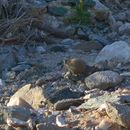en
names in breadcrumbs


The Dassie Rat (Petromus typicus) has a very unfortunate common name for it is neither a dassie (i.e. hyrax) nor a rat! Instead it should rather be called by its local Khoisan name, Noki. Dassie rats are squirrel-like in appearance. Their tails are hairy, but not bushy whereas the soles of their feet are distinctly bare and have pads. Their heads are noticeably flattened. The overall colouration can be a range of browns, greys, or almost black. The nose is yellowish and tends to stand out. They have no underfur. The female's teats are located on the sides of the torso, which allows the young to feed from the side when crammed in a narrow rock crevice.
Dassie Rats are restricted to rocky outcrops in Namibia, parts of Angola and north-west South Africa. They are famous for being able to squeeze into extremely narrow crevices. This is accomplished due to their flattened skulls and flexible ribs. Dassie Rats feed primarily on grassy parts, but will sometimes eat fruits, seeds, and leaves. They have high crowned and rooted cheek teeth. Females give birth to a pair of offspring just once a year; an unusually slow reproductive rate among rodents.
Dassie Rats are the only remaining members of a once diverse family that first appeared in the Oligocene of Africa (the Oligocene is a geologic epoch of the Paleogene Period and extends from about 34 million to 23 million years ago). Both morphological and molecular studies suggest the closest living relatives to the dassie rats are the African cane rats in the family Thryonomyidae. These two families along with related fossil families such as †Phiomyidae represented an important early radiation of rodents in Africa.
For more information on MammalMAP, visit the MammalMAPvirtual museumorblog.